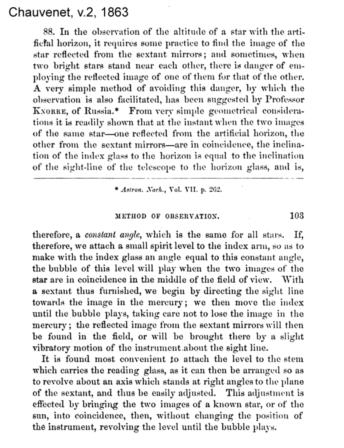
NavList:
A Community Devoted to the Preservation and Practice of Celestial Navigation and Other Methods of Traditional Wayfinding
From: Frank Reed
Date: 2023 Apr 19, 13:10 -0700
Chuck Varney, you wrote:
"I have attached a diagram that I did in 2016 showing how your observation has been put to use in the past--by fixing a rotatable spirit level to the index arm."
That's great. Thank you!
And you added:
"I have also attached one of the sources I found in 2016: page 554 from "Wrinkles in Practical Navigation (Lecky 1918)"."
Aha. This was an excellent clue! I came to this idea indirectly from the Knorre Level end. Someone asked about a level attached to the index arm at an odd angle on a sextant c.1900. I found a very brief reference to a level like that in an early 20th century sextant catalog. And from that description I speculated that it worked because of the constancy of that angle. But I dropped the matter and hadn't thought about it again until yesterday.
I had assumed from the description in that sextant catalog that this was a "trinket" that dated from that era. Your reference to Lecky got me digging deeper. The edition of Lecky you mentioned --1918-- still suggested early 20th century, but that then led to an edition of "Hints to Travellers" from 1871, much earlier than I expected. I was even more surprised that the editors of "Hints" referenced Chauvenet! And sure enough, there's an identical description in vol.2 of Chauvenet's famous "Spherical and Practical Astronomy" from 1863. Checking there, Chauvenet himself references Knorre's original account which he says is in the "Astronomische Nachrichten" vol.7. I have discovered previously that Chauvenet often references articles which were already decades old by the time he wrote about them (he had an excellent library in St. Louis, Missouri where he was writing by then, but it wasn't necessarily up-to-date). The article by Knorre where he first describes this "level" is from 1829!
I don't know German beyond a handful of words, but I was able to find the correct section by looking for the word for "dragonfly". I believe it was Bill Morris who discovered and pointed out some years ago that translations of "bubble level" from German to English often mistake it for "dragonfly". I used an OCR tool and then Google translate on the text [plus a few edits of my own, which I have indicated in square brackets]. It reads as follows:
I have given my sextant an arrangement which I find useful in observations of altitude. Anyone who has measured the heights of stars in the artificial horizon will have found that finding the image reflected by the mirrors requires some practice. Especially when two equally bright stars are next to each other, it is often difficult to avoid confusion. It has therefore often been suggested that the heights of the [stars to be observed should be pre-calculated]. This requires a preliminary knowledge of latitude, time and star position. There is, however, another [method] in which these limitations do not take place. For it follows from a simple geometric consideration that at the moment when the two images coincide, the inclination of the large mirror to the horizon is equal to the inclination of the line of sight of the telescope to the small mirror, i.e. a constant angle. If, therefore, a small [bubble level (not dragonfly!)] is attached to the [index arm], which is parallel to the plane of the arc of the degrees and makes the said angle with the large mirror, this will appear whenever the two images coincide in the middle of the field of view, and consequently can serve to find the 2nd image. One judges and makes the said angle with the large mirror, this will appear each time as soon as the two images coincide in the middle of the visual field, and can therefore be used to find the 2nd image. First direct the telescope to the image on the horizon; then, by moving the [index arm], bring the [bubble level] into play without losing the image from the middle of the field of view: then, if you hold the instrument exactly vertically, the 2nd image will also be in the field of view, or, if this is not the case, [make it so] by gently rotating the instrument around the axis of the telescope. On a mirror circle such a spirit level serves both for observation to the left and for observation to the right, if its two sides are as nearly parallel as is required for this purpose. and therefore saves a great deal of time in the case of frequent repetitions. I have found it most convenient to use the [bubble level] to be fastened to the pin which supports the loupe, rotating it about an axis perpendicular to the plane of the arc of the degree in this fastening. and therefore can be corrected with ease. This is done by aligning the two images of the sun or a star and then, with the instrument stationary, bringing the dragonfly into play. Incidentally, it is by no means my opinion to propose such a standard for measuring terrestrial angles of elevation, as has otherwise been done, inasmuch as there is a far more accurate means of determining, with a mirror instrument and a corrected watch, the azimuth and elevation of an terrestrial object . As is well known, this means consists in measuring the distance of the sun from the object at two different times of the day.
K Knorre.
Images from "Hints" and "Chauvenet" and the original Astron.Nachrichten article below.
Frank Reed
Clockwork Mapping / ReedNavigation.com
Conanicut Island USA









